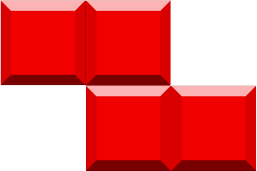What is Tetris?
Tetris is a tile-matching puzzle video game originally designed and programmed by Soviet Russian game designer Alexey Pajitnov in 1984.
In the game, random tetrominos fall down the playing field. The objective is to manipulate these tetrominos, by moving each one sideways and/or rotating by quarter-turns, so that they form a solid horizontal line with no gaps. When such a line is formed, it disappears and nay blocks above it fall down to fill the space. When a certain number of lines are cleared, the game enters a new level. As the game progresses, each level causes the tetrominos to fall faster, and the game ends when the stack of tetrominos reaches the top of the playing field and no new tetrominos are able to enter. Some games also end after a finite number of levels or lines.
Tetriminoes
Tetriminoes (deliberately spelled with 'Tetri-' instead of 'Tetro-') are game pieces shaped like tetrominoes, geometric shapes composed of four square blocks each.
The following table demonstrates each Tetrimino.
| Appearance | Name | Comments |
|---|---|---|
 |
I — AKA cyan piece, line, straight, stick. | This is the only one-sided Tetrimino that can clear four lines (a 'Tetris') in a traditional game. |
 |
J — AKA blue piece, reverse L, left L, lowercase R. | - |
 |
L — AKA orange piece, reverse J. | - |
 |
O — AKA yellow piece, square, block. | This is the only piece that cannot be 'rotated', for obvious reasons. |
 |
S — AKA green piece, right turn, right skew. | - |
 |
T — AKA purple/magenta piece, triangle, pyramid. | This Tetrimino is capable of doing the T-Spin (see the Techniques page for more info). |
 |
Z — AKA red piece, left turn, right skew. | - |
Where can I play Tetris?
You can play Tetris here!
And just about anywhere else, too... your TOASTER could probably play Tetris, in all honesty.